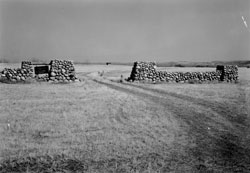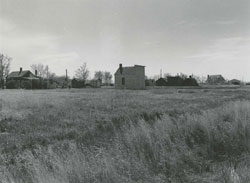We’ve launched a new web portal! Visit findhistory.nd.gov to search our collections.
Due to a road closure, the Killdeer Mountain Battlefield State Historic Site is temporarily closed.
Meanwhile, another fur trade post, Primeau's Post, had been constructed on the south side of the Arikara village in 1850 by a competitor, Harvey, Primeau, and Company of St. Louis. The fort was located between Fort Clark and the Arikara village. Charles Primeau, a former employee of the American Fur Company, started the competing company.
After the south half of Fort Clark burned in 1860, the owners purchased Primeau's Post, which they operated until 1861. Later that year, Primeau's Post and the Arikara village were abandoned after an attack by the Dakota. Passing steamboats scavenged firewood from the abandoned fort until at least 1865.
 Today Fort Clark is listed on the National Register of Historic Places and has been nominated as a National Historic Landmark. More than 2,200 surface features represent the ruins of houses, graves, storage pits, and other cultural remains. The location of houses in Mitu'tahakto's is indicated by a series of large, shallow, doughnut-shaped depressions. There are approximately 100 depressions marking the locations of Mandan and Arikara lodges. In the center of the village near the terrace edge is a flat, central plaza used by the Mandan for ceremonies. Later, the Arikara built a large, ceremonial lodge in the plaza. It is clearly visible as the largest earthlodge depression. Small depressions within the village mark subsurface storage pits, called cache pits, which were used for storing garden produce. Surrounding the village is a shallow fortification ditch which, combined with a palisade, protected the village from attack. Unlike palisades protecting prehistoric villages, the stockade at Mitu'tahakto's was outside the ditch.
Today Fort Clark is listed on the National Register of Historic Places and has been nominated as a National Historic Landmark. More than 2,200 surface features represent the ruins of houses, graves, storage pits, and other cultural remains. The location of houses in Mitu'tahakto's is indicated by a series of large, shallow, doughnut-shaped depressions. There are approximately 100 depressions marking the locations of Mandan and Arikara lodges. In the center of the village near the terrace edge is a flat, central plaza used by the Mandan for ceremonies. Later, the Arikara built a large, ceremonial lodge in the plaza. It is clearly visible as the largest earthlodge depression. Small depressions within the village mark subsurface storage pits, called cache pits, which were used for storing garden produce. Surrounding the village is a shallow fortification ditch which, combined with a palisade, protected the village from attack. Unlike palisades protecting prehistoric villages, the stockade at Mitu'tahakto's was outside the ditch.
 Beyond the fortification ditch are large, irregular pits from which soil was dug to cover earthlodges. Also visible are several small lodge depressions. Visitors, who often came to trade, camped outside the village. The long, low ridges shown on the map are difficult to see on the ground but are believed to outline horse corrals.
Beyond the fortification ditch are large, irregular pits from which soil was dug to cover earthlodges. Also visible are several small lodge depressions. Visitors, who often came to trade, camped outside the village. The long, low ridges shown on the map are difficult to see on the ground but are believed to outline horse corrals.
At the southeastern edge of the village are the remains of Primeau's Post. Between the post and the remains of Fort Clark is a large earthlodge depression, the location of the home of Pierre Garreau. Garreau, the Arikara stepson of a French-Canadian trader, raised vegetables inside a picket fence beside his home to sell to Fort Clark personnel. The fence abuts the palisade that protected Fort Clark from atttack.
Clusters of small, circular depressions and doughnut-shaped mounds near the railroad tracks mark graves. This unmarked cemetery, with approximately 800 graves, testifies to the tragedy of epidemics that nearly annihilated the occupants of the Mandan and Arikara villages.
Address:
Located 15 miles southwest of Washburn, ND.
follow: N Dakota 200 Alt W
Get Directions
Hours:
Open year-round.
Please note, there is no snow removal.
Contact SHSND:
phone: 701.328.2666
email: history@nd.gov